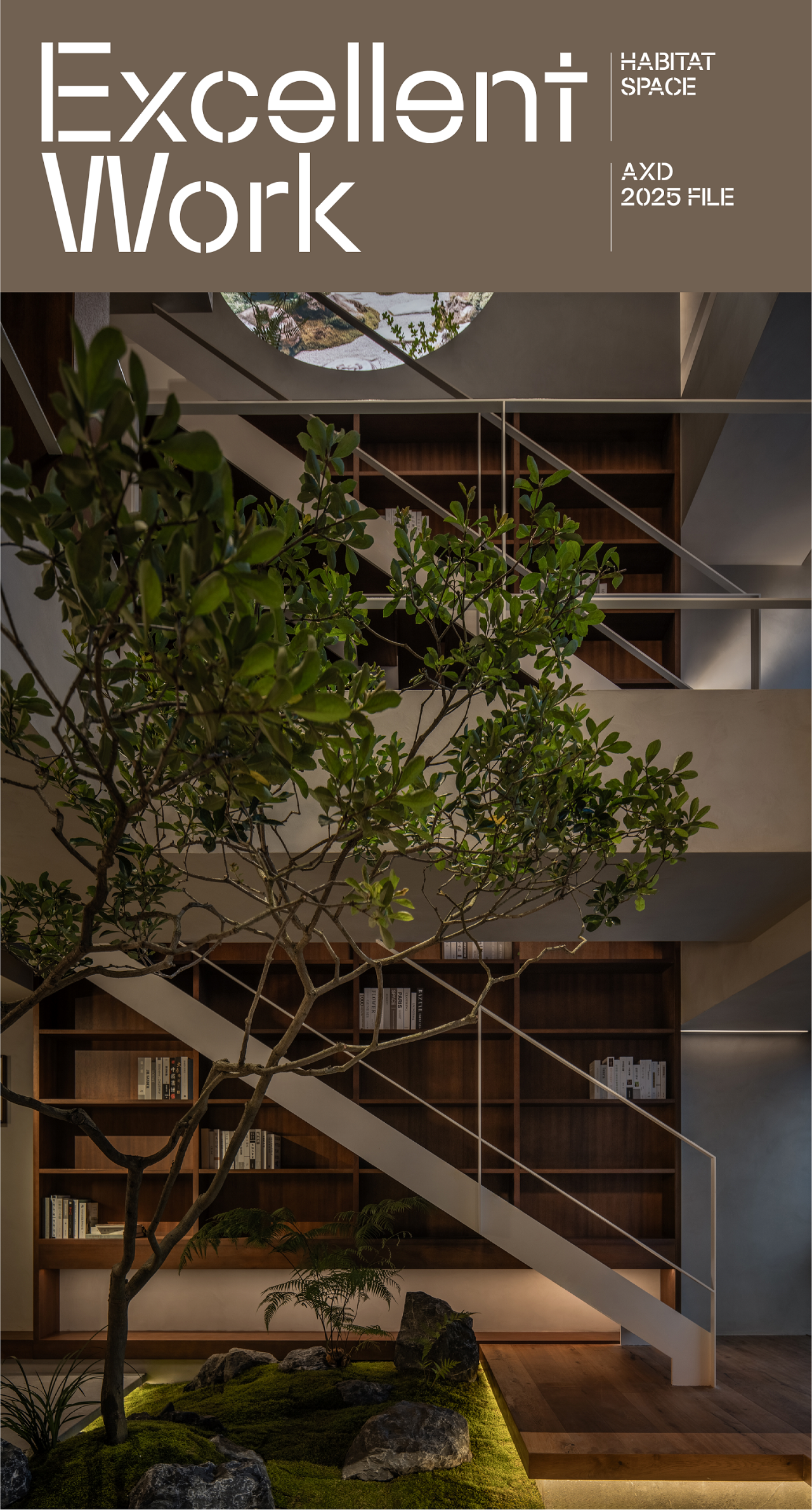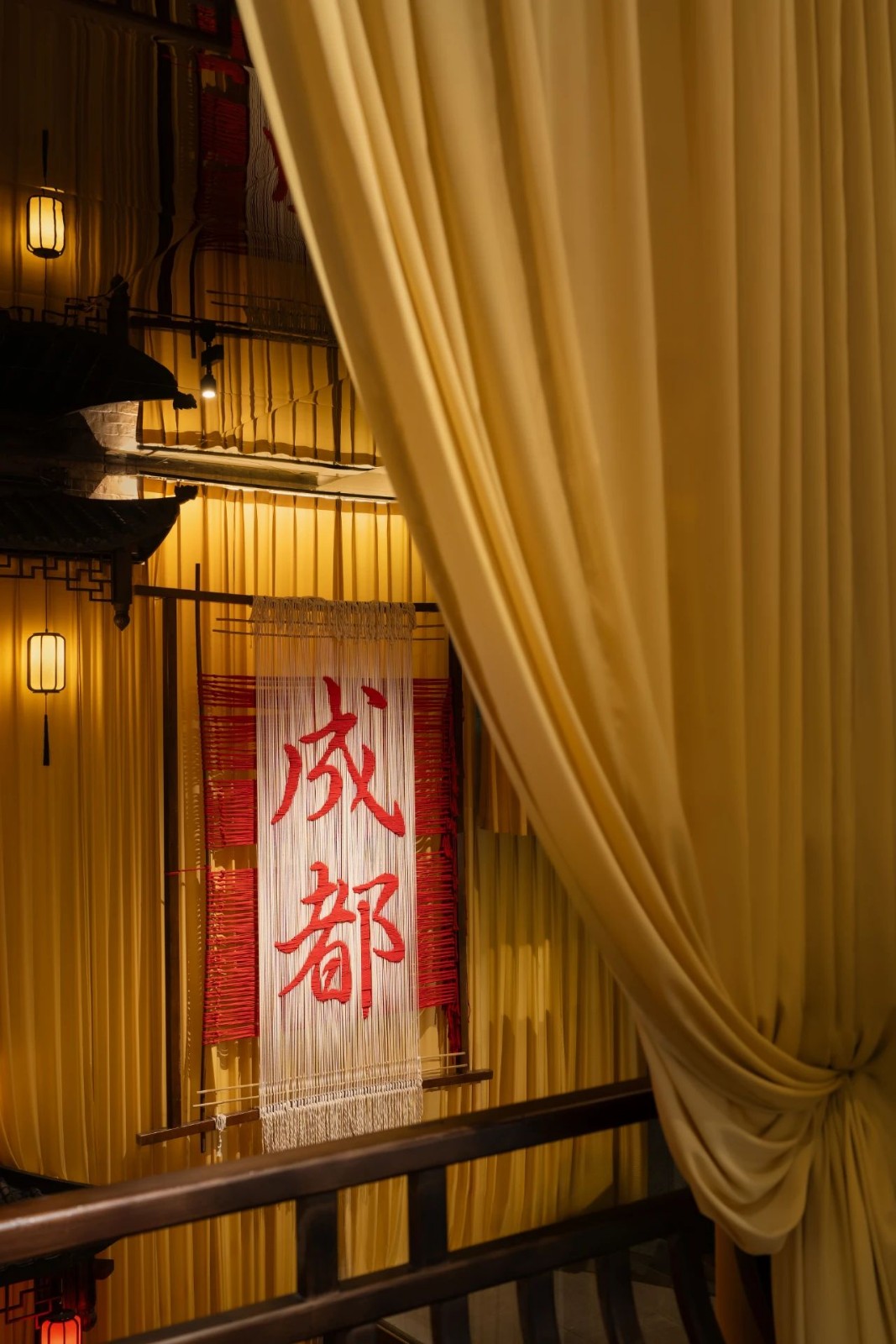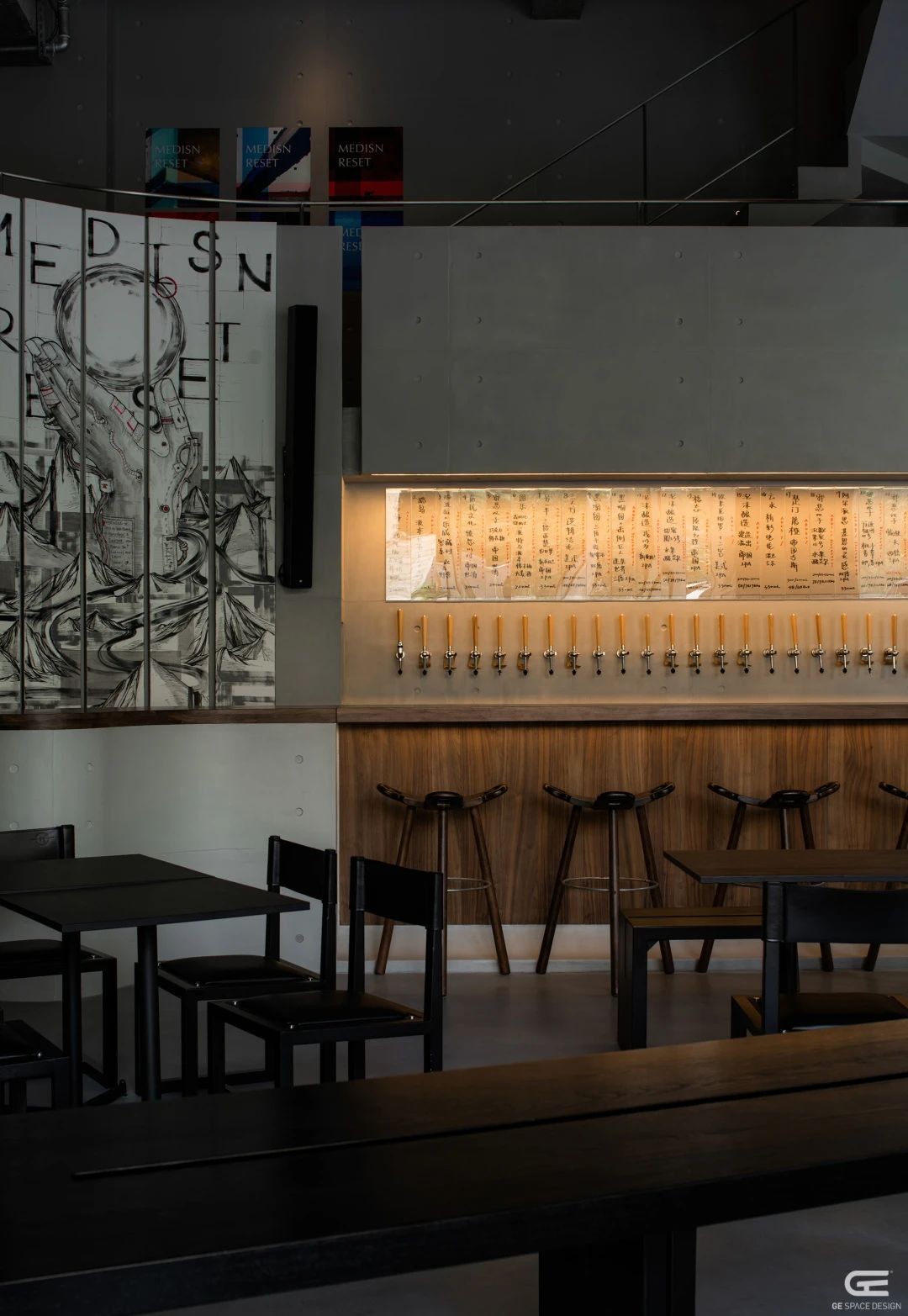新作|季意空间设计 x 古今共融:成都蜀锦织绣博物馆 首
2024-08-22 22:24
Situated by the Huanhua Creek, the Chengdu SHU Brocade and Embroidery Museum was built on the site of the original Chengdu SHU brocade factory, which has a 70-year history, and it opened to the public in 2009. In 2024, the museum underwent renovations with the aim of presenting the charm of the integration of ancient and modern SHU brocade and embroidery in a more contemporary and interactive manner.
成都蜀锦织绣博物馆所在的位置,原为成都蜀锦厂,现为国家级博物馆,是目前全国唯一一座专题展示蜀锦及传统织造技艺的博物馆。馆内文物藏品共计93973件,国家级珍贵文物48件。
The Chengdu SHU Brocade and Embroidery Museum, located on the site of the former Chengdu SHU brocade factory, is now a national-level museum and the only museum in China dedicated to the display of SHU brocade and traditional weaving techniques. The museum houses a total of 93,973 artifacts, including 48 nationally significant cultural relics.
成都蜀锦织绣博物馆,位于浣花溪畔,在具有70年历史的原成都蜀锦厂旧址上修建而成,于2009年对外开放。2024年,馆内重新翻修,意在以更当代、更具互动性的展陈方式,展现蜀锦与蜀绣的古今共融的魅力。
Situated by the Huanhua Creek, the Chengdu SHU Brocade and Embroidery Museum was built on the site of the original Chengdu SHU brocade factory, which has a 70-year history, and it opened to the public in 2009. In 2024, the museum underwent renovations with the aim of presenting the charm of the integration of ancient and modern SHU brocade and embroidery in a more contemporary and interactive manner.
成都蜀锦织绣博物馆一共两层。下层,实际上为负一层,是历史博物馆,溯源蜀锦与蜀绣历史起源,以及技艺、纹样、特殊性历史地位的演变过程。其中,不仅有大量根据历史记载复原的织锦绣样,更有珍贵的出土残片与文物,见证着蜀锦非同一般的过往。
The Chengdu SHU Brocade and Embroidery Museum has two floors. The lower floor, actually the basement level, is a historical museum that traces the origins of SHU brocade and embroidery as well as the evolution of techniques, patterns, and their unique historical significance. This section not only features a large number of restored brocade and embroidery patterns based on historical records but also showcases precious unearthed fragments and artifacts, bearing witness to the extraordinary past of SHU brocade.
上层,也即一层,为蜀锦蜀绣艺术展厅,是本次重点翻新的区域。这里展陈的蜀锦与蜀绣其重点不在于对历史文本的佐证与复现,而是作为艺术品被观看、欣赏、理解,并以此获得某种幽微的心灵启示。同样是观看,负一楼中历史博物馆的观看,是一种带着历史的迷思向更遥远过去的印证与探寻;而一楼艺术展厅的观看,则承载着充分的审美意义,是一次当代个体经验与传统蜀锦蜀绣技艺由眼入心的邂逅。
The upper floor, which is the ground level, serves as the SHU brocade and embroidery art gallery, and it is the main focus of the recent renovations. The exhibits here emphasize not the corroboration and reproduction of historical texts but rather the appreciation and understanding of SHU brocade and embroidery as works of art, offering subtle spiritual insights. Viewing the historical museum in the basement is an exploration and verification of the distant past, filled with historical mysteries. In contrast, viewing the art gallery on the ground floor is a highly aesthetic experience, a contemporary encounter where traditional SHU brocade and embroidery techniques resonate deeply with the observers personal experience.
尽管,整个博物馆分为两层,但在其中心位置上,有一个竖向挑空的中庭,将负一层与一层空间的横向延展截断,形成交织关系。空间中的游走、对望与互通,皆因这个中庭而有了趣味上的变化。更具象征意义的是,负一层历史博物馆与一层艺术展厅,分别从两个不同的时间维度(历史与当代)横向展开,挑空的中庭则在垂直维度上向天地两端延续,形成以“空间为经时间为纬”的总体格局。
Although the museum is divided into two floors, a vertical atrium at its center interrupts the horizontal extension of both the basement and the ground floor, creating an interwoven relationship. The wandering, gazing, and communication in the space have all undergone interesting changes due to this courtyard. Symbolically, the basement historical museum and the ground-floor art gallery unfold horizontally from two different temporal dimensions—history and the present—while the atrium extends vertically, connecting the heavens and the earth, establishing an overall layout of space as the warp and time as the weft.
在过去的两千年历史中,蜀锦多以经线起花,且为蜀锦之独有,讲究“经正而后纬成”。由此,以空间为经的中庭,自然在整个蜀锦织绣博物馆中承担起“经正”的核心意义,为上下两层空间的“纬成”提供支柱与依据。
Over the past two thousand years, SHU brocade has primarily been woven with warp threads, a unique characteristic of SHU brocade that emphasizes a straight warp leads to a completed weft. Thus, the atrium, representing space as the warp, naturally assumes the core significance of straight warp within the Chengdu SHU Brocade and Embroidery Museum, providing the support and foundation for the completed weft of the upper and lower spaces.
The atrium is a dramatic centerpiece, making a striking and theatrical entrance.
利用中庭挑高的优势,在狭长两侧设屋瓦飞檐,檐下浅辟窗景与庭栏,旨在写意,重现往昔锦官城内街市熙攘的景象。既然是戏剧性表现,适度的夸张反而更显叙事张力,故而借用大量正黄与正红的戏曲帷幕,增加空间的整体性与虚实感。与此同时,空间顶部利用镜面不锈钢,将市井街巷之层次向上延伸,在视觉上赋予空间高旷之感。
Leveraging the vertical space of the atrium, flying eaves with roof tiles are set along the narrow sides, with shallow windowscapes and courtyard railings beneath them, aimed at evoking an impressionistic scene of the bustling streets of the ancient Jincheng. Given the theatrical approach, a degree of exaggeration enhances the narrative tension, thus the extensive use of opera curtains in bright yellow and red increases the spatial coherence and interplay of reality and illusion. Simultaneously, the ceiling features mirror-finish stainless steel, extending the layers of the market streets upward, visually imbuing the space with a sense of vastness.
其中一台为清代道光年间小花楼木织机,长6米,宽1.5米,高5米。是目前唯一一台仍在使用的清代道光年蜀锦小花楼木织机,分上下两层,分别负责投梭与挽花,操作时需两位织锦艺术家协同配合进行。
One of the machines is a small flower tower wooden loom from the Daoguang period of the Qing Dynasty, measuring 6 meters in length, 1.5 meters in width, and 5 meters in height. It is the only remaining operational small flower tower wooden loom from the Daoguang period, with an upper and lower level dedicated to shuttle throwing and pattern weaving, requiring the coordinated effort of two brocade artisans.
街巷之下,是一大一小两台尺寸巨大的楼织机,楼织机内侧,设廊桥,利于穿行,其后是等高的影视屏幕,在虚实掩映之间,将街道向更深处延伸而去。在这个虚设的剧场里,灯笼四起,黄昏满月,或凭栏而立,或倚窗相望,听机杼之声如汤汤江水,别有一番“贝锦斐成,濯色江波”的梦幻之境。
Beneath the market streets are two large tower looms, one large and one small. Next to the tower looms, a gallery bridge facilitates passage, and behind it, there is a screen of equal height. This screen extends the street scene further into the depths through the interplay of reality and illusion. In this virtual theater, lanterns rise, a full moon graces the dusk, and one might stand by the railing or gaze through a window, listening to the sound of the loom like the flowing waters of the river, creating a dreamlike scene of colorful brocade completed, washed by river waves.
从中庭上来,进入艺术展厅的第一个空间,是一个以蜀锦展示为主题的穿行空间。以“引”为契机,既是穿针引线,也是引人入胜。
Ascending from the atrium, you enter the first space of the art gallery, a passageway themed around the display of SHU brocade. This space, with the theme of guidance, serves both to thread the needle and to captivate visitors.
在手法上延续中庭的“幻境”之意:蜀锦垂挂,如瀑布高悬,如天光倾泻;动线曲而蜿蜒,人穿行其间,或游走,或绕行。镜面不锈钢材质的多维度使用,放大了空间的尺度,制造出空间的幽深之感,使得作为展品的蜀锦,经由光而在空间中被充分强调。同时,展台上的镜面不锈钢,在顶面投射出粼粼波光,水中濯锦的场景与想象力也因此得以重合。
The design continues the illusion concept of the atrium: SHU brocade hangs like waterfalls cascading from great heights, as if daylight is pouring down. The pathways are curved and meandering, allowing visitors to stroll or navigate around. The multidimensional use of mirror-finish stainless steel amplifies the spatial scale, creating a sense of depth, and highlights the SHU brocade exhibits with light. Additionally, the mirror-finish stainless steel on the display platforms reflects a shimmering water effect on the ceiling, merging the imagery and imagination of brocade being washed in water.
千佛堂的位置,位于以“引”为契机的迷宫幻境之后,是“引”最直接的目的地,千佛接引故此而来,名正言顺。千佛堂之后,是蜀绣在古代文人日常生活中的场景重现,如此“先出尘后入世”的做法,亦未尝不是一种保持心性纤尘不染来看待蜀绣技艺与艺术作品的明智之举。
The Hall of a Thousand Buddhas is situated after the labyrinthine illusion themed around guidance, making it the most direct destination of the guidance concept, thus its name is fitting. Beyond the Hall of a Thousand Buddhas lies a reenactment of scenes from the daily lives of ancient scholars featuring SHU embroidery. This approach of transcending the mundane before entering the world serves as a wise means to maintain a pure perspective when appreciating the techniques and artworks of SHU embroidery.
由蜀锦工艺制成的千幅佛像于两侧整齐排列,形成守护供养之势,供案之后,是巨幅蜀绣大师匠作《西方极乐世界阿弥陀佛接引图》。
In the Hall of a Thousand Buddhas, a thousand Buddha figures made from SHU brocade are neatly arranged on either side, creating a guardian and offering presence. Behind the offering table is a massive SHU embroidery piece by a master artisan, titled Amitabha Buddha’s Guidance to the Western Pure Land.
佛堂空间周正而对称,有着极其庄严的古典美学。在这个空间中,蜀锦与蜀绣交织:一千枚蜀锦织就的佛像供奉于两侧格式佛龛内,形成气势恢宏的矩阵,巨幅蜀绣大师匠心之作《西方极乐世界阿弥陀佛接引图》,位于空间中轴线上方,成为千佛堂最核心的视觉焦点。
The space of the Buddha hall is symmetrical and perfectly aligned, embodying a classical sense of solemnity. Here, SHU brocade and embroidery intertwine: a thousand SHU brocade Buddha figures are enshrined in ornate niches on either side, forming an impressive matrix. Above the central axis of the space, the grand SHU embroidery piece, Amitabha Buddha’s Guidance to the Western Pure Land, becomes the focal visual point of the Hall of a Thousand Buddhas.
向古典园林中借两方月洞门,圆润饱满,平底包边,一前一后,相映成趣。前有中庭挑灯飞檐、造就街巷市井之热闹,后有室内开洞纳景、屏绣虚掩,勾勒园林之雅趣。只不过在这里,空间小景皆由古典的桌案榻椅与蜀绣作品来完成,不事夸张,只为还原一种往昔的灵韵。
Borrowing two moon gates from classical gardens, they are round and full, with flat edges, positioned one in front and one behind, creating a charming interplay. The front moon gate reflects the lively street scene with its illuminated flying eaves, while the rear moon gate frames the view with indoor openings and embroidered screens, evoking the elegance of a garden.In this space, the small scenes are completed by classical tables, couches, and chairs, along with SHU embroidery works. There is no exaggeration here—only an effort to restore the spiritual essence of bygone days.
中央区域,设置绣架两台,尽管不可避免有表演的成分,但更多是为形成一种对蜀绣最为直观的互动体验。
In the central area, two embroidery frames are set up. While there is an element of performance, the primary goal is to create a direct and interactive experience with SHU embroidery.
因为刺绣对于光线的要求极高,展厅内多以局部灯光为主,因此在绣架区域上方搭建一个刚好覆盖两台绣架的屋檐式顶灯,既不破坏整体展厅的古典气质,又解决了刺绣时光线不足的问题。
Since embroidery requires very precise lighting, the exhibition hall predominantly uses localized lighting. Therefore, a canopy-style ceiling light is installed above the embroidery frames, covering both frames. This design maintains the classical aesthetic of the exhibition hall while addressing the issue of insufficient lighting for embroidery.
蜀绣,除了出现在古代服饰上之外,还常以屏的方式成为古代文人生活中极为常见的家居什物。
SHU embroidery, beyond its historical use in ancient garments, also frequently appeared as decorative screens in the homes of scholars.
在对蜀绣的展示布局上,以屏绣构建的小景为主,场景之间自然衔接并连续展开,形成一个可观、可游、可坐、可把玩的连续性体验空间。在这里,展厅中呈现的信息可以在人与物、人与空间的互动中持续发酵,从历史与空间的双重维度构建古今叙事,达成空间文化共识的同时,也赋予蜀绣以强烈的人文精神内涵。
In the display layout for SHU embroidery, the focus is on creating small scenes using embroidered screens. These scenes naturally connect and unfold continuously, forming an immersive space that allows for observation, exploration, sitting, and interaction. Here, the information presented in the exhibition hall can evolve through the interaction between people and objects, as well as between people and space. This approach constructs a narrative that spans both historical and spatial dimensions, fostering a cultural consensus while imbuing SHU embroidery with a profound humanistic spirit.
离开园林式蜀绣展厅,进入画廊,进入当代艺术的语境之中。
Leaving the garden-style SHU embroidery exhibition hall and entering the gallery shifts the context to contemporary art.
作为日常用品的蜀绣,是《长物志》中移情入趣的所在,审美上的互动与日常生活上的使用皆而有之。而作为当代艺术品的蜀绣,展示于画框之内,获得的是一种纯粹的观看与欣赏,是由眼入心、审度于物我之间的文化审美体验。
As a daily item, SHU embroidery represents a form of emotional engagement and aesthetic interaction, as seen in Treatise on Superfluous Things where it merges interest with daily use. In contrast, as a contemporary art piece displayed within a frame, SHU embroidery provides a pure experience of viewing and appreciation. It offers a cultural and aesthetic experience that moves from the eyes to the heart, engaging in the relationship between object and self.
长廊内,左右两侧分别设立若干隔屏,将长廊等比而分,形成两个连续的隔屏阵列,只留出一个整齐的通道,赋予空间以古典的对称感与秩序感。
In the long corridor, several partitions are set up on both sides, dividing the space into two continuous arrays of partitions, leaving only a neatly aligned passage. This design imparts a classical sense of symmetry and order to the space.
为了使人在进入长廊第一时间关注到前端那件以《五星出东方利中国》织锦图案为元素而创作的巨幅匠作,设计上巧妙利用两侧隔屏的双面性,让正面空置,形成一个相对干净且呈阶梯状向中心处指引的背景,完成视觉对作品的锚定。
To ensure that visitors immediately notice the large, masterful piece at the front of the corridor, which features the Five Stars Rising in the East Benefit China brocade pattern, the design cleverly utilizes the dual-sided nature of the partitions. The front faces of the partitions are left empty, creating a relatively clean and step-like background that directs attention towards the center and anchors the visual focus on the artwork.
将蜀绣作品完全抽离于纷繁复杂的历史背景之中,仅以背景墙上的描金山水为依托,独立、开放地展现于展厅的聚光灯之下。看似简单,却不仅仅只是一次作品的当代性展陈,更重要的是帮助蜀绣完成了一次身份上的彻底转变:从一个为物赋形的装饰物,成为物的主体与物的全部内容。
The SHU embroidery works are completely removed from their complex historical context and are independently and openly displayed under the spotlight of the exhibition hall, relying solely on the gilded landscape on the background wall. This seemingly simple presentation is not just a showcase of the artworks contemporary aspect but, more importantly, facilitates a profound transformation of SHU embroiderys identity: from a decorative element that shapes objects to the primary subject and entirety of the object itself.
这些有着历史传承的作品,在观看与被观看的互动中,在视觉的焦点与视线的来回摩挲间,它们的光芒被重新点燃,它们的生命被赋予新的时代特征。古今共融,当是蜀锦蜀绣艺术最灿烂的姿态。
These works, with their historical heritage, have their brilliance reignited and their lives endowed with new characteristics of the era through the interaction between viewing and being viewed, and the visual focus and gaze. The integration of ancient and modern represents the most radiant form of SHU brocade and embroidery art.
有态度的设计师,环境工程专业出身,专注于环保空间设计,不喜欢过度装饰,更注重让居住者回归生活的本身,用最基本的形式, 展现空间对使用者的表述
《City of Sky》《MEDISN RESET》
2023 第十一届筑巢奖 专业类公共文化空间 金奖
2023 第十一届TINTA金邸奖商业空间餐饮类提名奖
2023 iF DESIGN AWARD德国iF设计奖
2023 MUSE 缪斯设计奖 Restaurants - Bars类 银奖
2022 Ariston国际室内设计大赛 年度空间设计杰出奖
2022 Ariston国际室内设计大赛 年度最佳空间设计金奖
2022-2023 40UNDER40中国(四川)设计杰出青年
2021 PChouse私宅设计大奖 年度TOP10作品奖
2020 PChouse私宅设计大奖 全国TOP100杰出设计师/设计机构奖
2020 PChouse私宅设计大奖 年度TOP100作品奖
“性格与习惯才是构成空间尺度的最佳参照。GE认为不论是人还是品牌,都应该从真正的“自我”出发。更强调内部的“自我个性”而非外部影响;更强调空间中从品牌性格与文化内核出发的功能性,而非刻意形成某种风格。
季意空间设计机构 GE space design,2015 年创立于成都。服务领域包含酒店、民宿、高品质私宅及个性商业空间。
尊重自我的表达、自然的生长;重视团队与效率、创意和可靠;坚信设计最本质的目的是解决问题及带来价值。更重要的是,我们始终乐意与不同的委托者一起创造环保、新睿、别致、可持续的美学生活体验。不盲目跟从权威、主义、榜样,New Generation - New Experience。
采集分享
 举报
举报
别默默的看了,快登录帮我评论一下吧!:)
注册
登录
更多评论
相关文章
-

描边风设计中,最容易犯的8种问题分析
2018年走过了四分之一,LOGO设计趋势也清晰了LOGO设计
-

描边风设计中,最容易犯的8种问题分析
2018年走过了四分之一,LOGO设计趋势也清晰了LOGO设计
-

描边风设计中,最容易犯的8种问题分析
2018年走过了四分之一,LOGO设计趋势也清晰了LOGO设计









































































































































